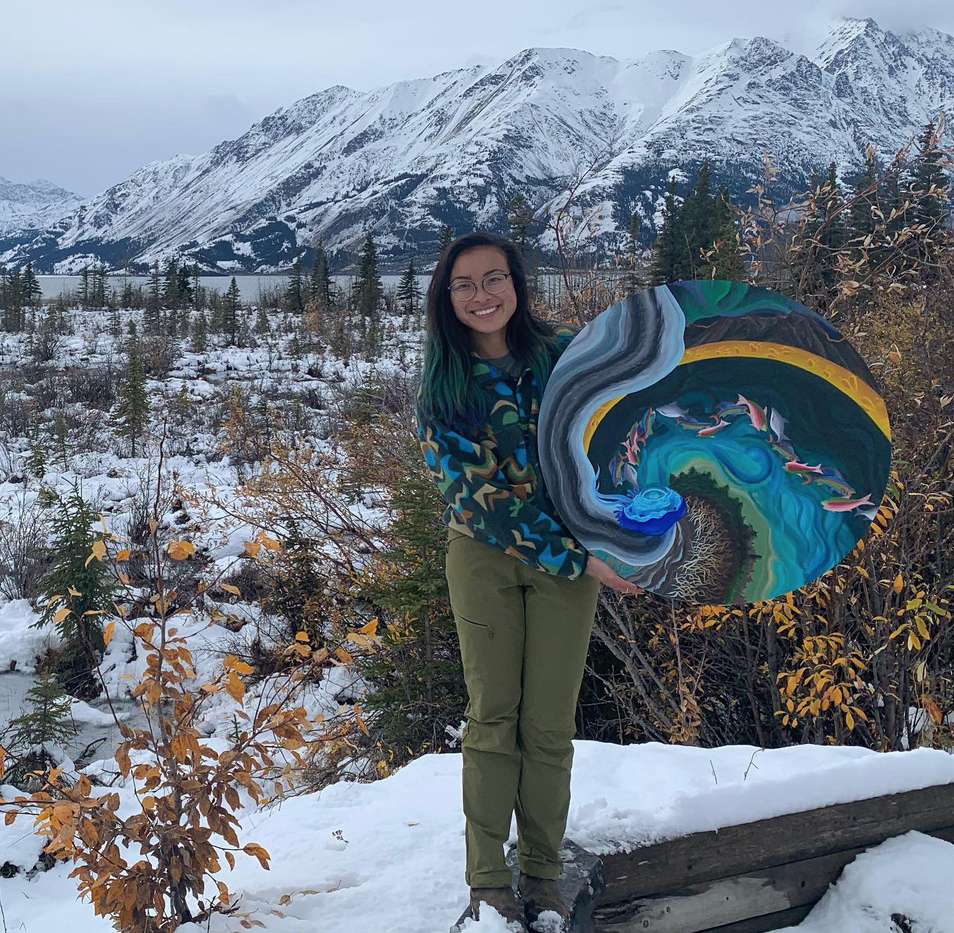March 7, 2023
Artist residency program explores science, conservation, and art in the Yukon: Apply by March 20

When artist Megan Leung describes the Kluane Lake Research Station in Yukon, it paints a picture in your mind.
“It’s by this massive network of glaciers and the research station is lakeside to the largest lake in Yukon Territory. It's this gorgeous glowing blue and there are beautiful mountains and boreal forests around you,” she says.
“If you're lucky enough to go there in autumn when the colours are changing, it's a magical place. And yes — it's worth staying up late to watch the northern lights, because it will be forever ingrained in your memory.”
Her description of Kluane Lake (called Lhù’ààn Mânʼ in the local Southern Tutchone language) is just as vivid as the art inspired by it.
In 2022, Leung spent two months at the Kluane Lake Research Station (KLRS) as its artist in residence. She captured the connection between art, science and community in her painting, Kluane’s Symphony. The success of Leung’s residency led to the creation of a new program in partnership with Parks Canada and the Yukon Arts Centre (YAC).

Megan Leung holds up her painting, Kluane’s Symphony.
Kristina Penn
Applications open for artist residency until March 20
“We’re thrilled to be launching the Kluane National Park Artist Residency in partnership with Parks Canada and the YAC,” says Kristina Penn, PhD candidate and program lead for KLRS.
“Having Megan at the station last summer was inspiring for our researchers and the community. The partnership is enabling KLRS to expand on what we did with Megan last year to host more artists in a more robust way.”
There are two separate two-week residencies between June and September each year in 2023 and 2024. Artists will engage with researchers at KLRS, present public workshops and drop-in sessions, as well as provide the program partners with at least one image of an artistic work or product that was created during the residency. The artists’ work will be showcased at the KLRS open house and/or the Northern Nights Festival in Kluane Lake National Park.
The residency includes a $3,000 honorarium from the YAC, full access to Kluane National Park, and accommodations and meals at KLRS. Artists will have opportunities to access scientists, ecological experts, and Parks Canada staff to help inspire their work and plan their public programs. Artists can apply on the YAC website before March 20, 2023.
“We strongly believe in the potential for art as a science communications tool,” says Penn. “The residency is the perfect setting to explore the interplay between science, conservation, and art, and give artists a chance to share their work and connect with people from all over the world.”
One of the most rewarding parts of the residency for Leung was sharing her “disruptive” approach to art and science with researchers, community, and school groups for whom she put on workshops.
“It was really great to show the possibilities of interdisciplinary methods and how if you enjoy two things, like art and science, you can actually do both of them!” she says.
“You don't have to fit into a box; sometimes, you really need to just break the box.”
For Leung, a master’s student studying arctic hydrology in the Department of Geography at UCalgary, that looked like spending time in the field with researchers to see the land from their point of view, and then including their research in her painting.
“I would focus one day on soil, and another day on water, or spruce needles, or the glaciers. It’s a cool way to gain a more well-rounded understanding of the landscape.”
Who should apply?
Leung doesn’t want any artists to get the impression a scientific or research background is required to get as much as she did out of the residency.
“You just need to be someone that appreciates nature, finding comfort in admiring the little things about a landscape. You can paint from reference images and that's all fine and good, but when you're staying somewhere and you're immersed in the place, that’s when the seemingly inanimate becomes a little more animated.”
Artists can apply for the Kluane National Park Residency until March 20, 2023. For more information on the program, visit the YAC website. Learn more about Megan Leung’s art on her website.

Kluane’s Symphony.
Megan Leung
- Photo above: Kluane’s Symphony illustrates how the expansive landscape of Lhù’ààn Mân (Kluane Lake) and all the meaningful work that researchers, youth groups, and community members I had the honour of spending time on the land with inspired me. This piece begins with the extensive roots systems of the diverse flora and fauna of the subarctic boreal forest, including the vibrant fireweed of the Yukon, migrating to the shores of the deep turquoise glacial waters, rich with arctic graylings, rainbow trout, and mountain whitefish. These waters are connected to the land by the fluxes of surface and subsurface water flow, as well as large game that hunt them, many of which travel to much higher elevations, where Thechàl Dhâl (Sheep Mountain) overlooks these braided waters fed by the sweeping Kaskawulsh Glacier via the Ä’äy Chù (Slims River). At night, the aurora borealis dances through the dark skies, while all other complex organisms that originated from eukaryotic cells are at rest.
- Megan Leung
Kluane Lake Research Station (KLRS) is part of the Arctic Institute of North America. KLRS is located 220 kilometres northwest of Whitehorse, Yukon, on the south shore of Kluane Lake (Lhù’ààn Mân), on the traditional lands of the Kluane, Champagne and Aishihik, and White River First Nations.
The Arctic Institute of North America (AINA) is Canada’s first and longest-lived Arctic research institute. AINA was created by an Act of Parliament in 1945 as a nonprofit, tax-exempt research and educational organization, and has been a part of the University of Calgary since 1976.






